Thank you for visiting! By the way… any links on this page that lead to products on Amazon and other stores/partners are affiliate links Aquarium Store Depot earns a commission if you make a purchase.
When you first bring home your new Oranda goldfish, it can be overwhelming with all the things you have to do. You may worry about how much water to change each week and what kind of food to feed them. But don’t fret! I’m here to help!
I’ll teach you everything there is about caring for your Oranda goldfish – from tank size requirements and the best type of food, to proper feeding techniques and even a few tips on breeding fish. So get ready because we are about dive deep into this fascinating Goldfish!
A Brief Overview Of The Oranda Goldfish
| Scientific Name | Carassius auratus |
| Common Name (Species) | Oranda Goldfish |
| Family | Cyprinidae |
| Origin | China |
| Diet | Omnivore |
| Care Level | Easy |
| Activity | Active, social |
| Lifespan | Up to 15 years |
| Temperment | Peaceful |
| Tank Level | All Areas |
| Minimum Tank Size | 30 Gallons |
| Temperature Range | 65 – 72 Degrees F |
| KH | 150 |
| pH Range | 6.0 – 8.0 |
| Filtration/Flow Rate | Moderate |
| Water Type | Freshwater |
| Breeding | Egg-layers, Easy to breed |
| Compatibility | Peace commuity species |
| Ok, For Planted Tanks? | With Research |
Origins and Habitat
The Oranda Goldfish is a beautiful and hardy cold water fish with an interesting history. Originating in China, this variety of goldfish was bred to resemble the Chinese Lion Dog. The lion dog features prominently on many pieces of art, furniture and jewelry as well as serving as guardian for the temples where it was kept!
They are descendants of Wild Carp and Goldfish (Carassius auratus). They are an artificially cultivated breed, also known as the Red Cap Oranda Goldfish. There are no Oranda Goldfish living in the wild, as they are raised in captivity. Their distant relative, the Prussian Carp, can still be found today in the slow-moving fresh waters of Central Asia.
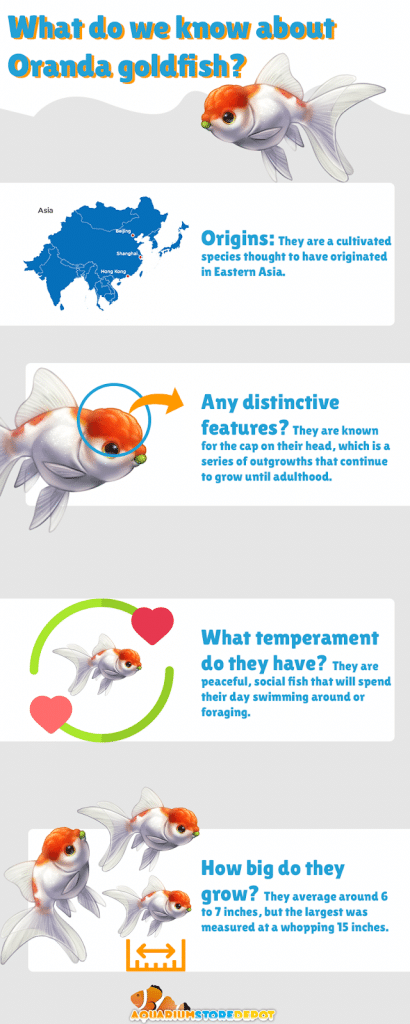
What Does the Oranda Goldfish Look Like?
Oranda Goldfish Carassius auratus are egg-shaped fish and can be identified by the cap on their head. This is a series of outgrowths that can be easily spotted and is also known as the “wen”. The head growth develops as the fish ages and normally starts appearing when the fish is four or five months old. They are different than a lionhead or Ranchu goldfish due to their dorsal fin.
There are different types and colors, with the most common being a shimmering yellow or orange Oranda. Some of the most distinctive Oranda Goldfish species are:
- Black Oranda Goldfish: This is a stunning but sinister fish that’s completely black, including its black cap.
- Blue Oranda: Goldfish These are extremely colorful fish that come in every shade of blue, from light, baby blue to vibrant, cobalt blue.
- Red Cap Oranda Goldfish: This Oranda Goldfish is the most popular species. It’s completely white with a bright red cap that stands out. This fish breed comes from the aquarium Goldfish Carassius auratus.

(Source)
How Big Are They?
Oranda Goldfish generally grow to around 6 or 7 inches. However, they have been known to grow to double this size in well-maintained tanks or ponds.
Most of the length of the fish is due to its tail fin, which can be up to two-thirds of its length in some species. The largest Oranda Goldfish ever recorded was a whopping 14 inches long and named Bruce.
How Long Do They Live?
The life expectancy of an Oranda Goldfish Carassius auratus is largely dependent on the care given and their surroundings.
These fancy Goldfish have a potential lifespan of between 10–15 years but have been known to live beyond this, up to 20 years in some cases. Proper care will allow your fish to live beyond the average goldfish lifespan.
Temperament and Activity Level
Oranda Goldfish peaceful fish with a calm temperament. They keep themselves away from any trouble. They are social and friendly fish. They will get along with most other fish, especially other breeds of Goldfish Carassius auratus.
They are pretty active and will spend most of the day swimming around the tank. They’re great fish to observe, and you’ll never tire of watching them gracefully swimming, digging, and foraging.
What Are Good Tank Mates?
Oranda Goldfish are great tank mates and can live with most species, but some are better than others.
Good Tank Mates
These fish love spending time with other Oranda Goldfish or similar fancy Goldfish varieties. If you get other species, they should be able to live in the same living conditions and at the same water temperatures. Other fancy variety Cyprinid fish like the Pearlscale Goldfish or Catfish are other freshwater fish that are good tank mates for the Oranda Goldfish. They will also keep the tank clean and clean up after the Goldfish, which can be a little messy.
Fish Species to Avoid
Small fish can be mistaken as a snack for your Oranda Goldfish, so it’s best to avoid putting them together. You don’t want any fin-nippers that could cause damage to your beautiful Oranda, such as Neons, Mollies, or small Barbs.
Oranda Goldfish are not the quickest swimmers; they like to saunter rather than speed along. This isn’t ideal when racing against a speedy comet for lunch.
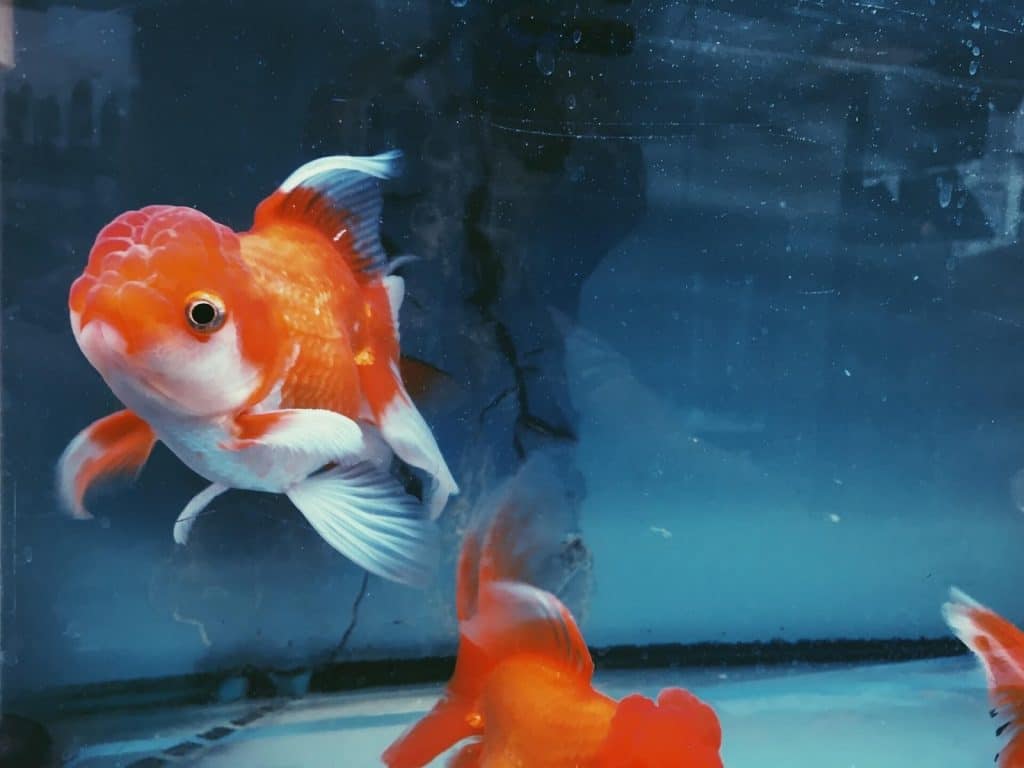
(Source)
What Do They Eat?
Oranda Goldfish aren’t fussy eaters; they are omnivores and will eat pretty much anything. They can be greedy and will eat whatever they can get in their mouths, including any small fish or invertebrates that may be in the tank.
They like to eat flake foods or pellets and will also eat nutritious spinach or salad. For staple pellet food, I recommend NorthFin Goldfish Food.
The Best Goldfish Pellet
Specially designed for goldfish and free from fillers
What About Live Foods?
Your Oranda Goldfish needs a varied, balanced diet, and live foods are an excellent way to add to this. They like high protein foods, such as bloodworms, tubifex worms, brine shrimp, and daphnia.
How Much and How Often To Feed?
You should be careful not to overfeed your Oranda Goldfish as they don’t seem to have a full sensor and will just keep eating. Feed younger fish twice a day and adult fish just once a day.
Small portions are a good way to control how much your fancy Goldfish eats every mealtime.
Tank Requirements
The tank requirements for Oranda Goldfish are not restrictive, and they can be kept quite simple in the right environment.
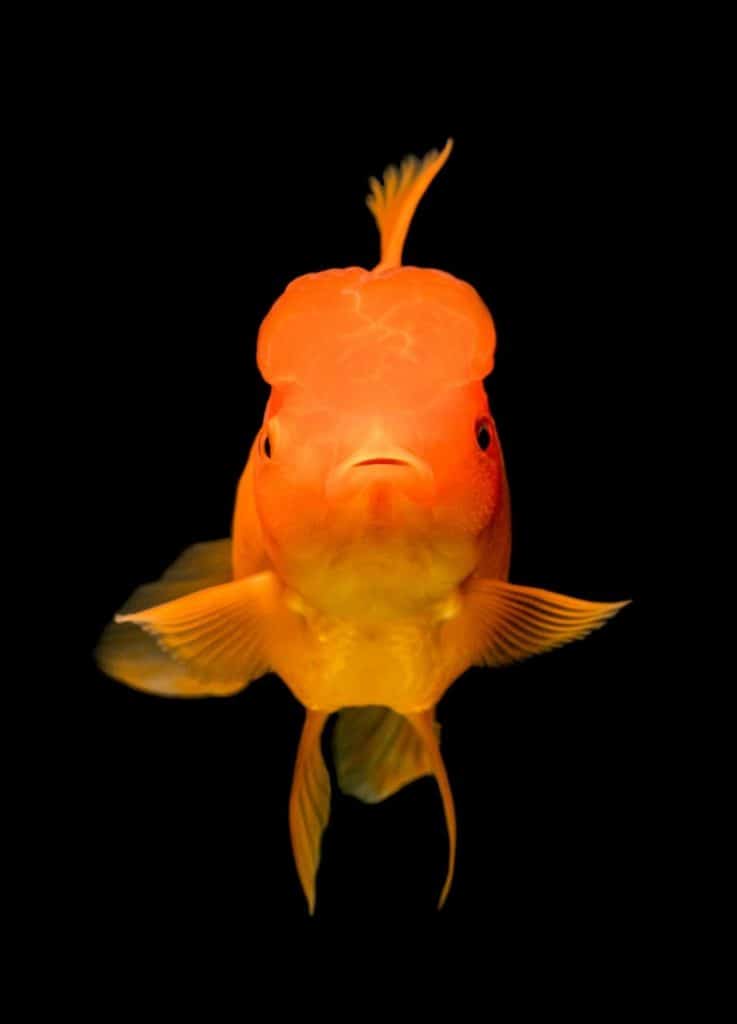
(Source)
Tank Size
If you’re starting off with just one Oranda, make sure you have the right tank size. It should be at least 20 gallons for one fancy Goldfish. For every additional fancy Goldfish you add to the tank, you should increase the tank size by 10 gallons.
They aren’t speedy swimmers, but they do need lots of room, and they can grow quite big, quite quickly. They also create a lot of waste, so a larger tank will help to give a healthier environment for your fish.
Tank Setup
Oranda Goldfish aren’t fussy and don’t need much to keep them happy, so their tank setup is relatively easy.
They need plenty of space when swimming around, and they have the wen on their head that may compromise their eyesight. With this in mind, you should not over-decorate the tank.
Oranda Goldfish like to dig, so make sure that the substrate you choose isn’t sharp and won’t harm them. Sand or rounded gravel is a good choice, and your fish will have hours of fun digging.
Freshwater plants are good to have, but these should be hardy as your fish will like to eat the plant leaves. They may also damage more fragile aquatic plants when digging and scattering the sand or gravel. Lighting for your tank isn’t necessary for the fish, but it may help with your live plants. Hardy plants that are column feeders like java fern do well in fish tanks with Orandas.
Water Quality
Oranda Goldfish are freshwater fish that can be sensitive to water temperature. It’s essential to get the water conditions, quality, and temperature just right.
Filtration
Oranda Goldfish Carassius auratus can be mucky and create a lot of waste, so you need a good filtration system. An efficient filter will remove all toxins from the tank and keep the water clean.
However, your fish can become stressed by strong water movement, so keep this in mind when getting a filter. An adjustable flow outlet will help with this, or you can redirect the flow via the plants away from the swimming area. Due to their messy nature, filtration is one of the most important water parameters of oranda goldfish care.
Water Parameters
Oranda Goldfish like to be in cooler freshwater with a temperature between 65–72 degrees Fahrenheit. They prefer a neutral pH level, which should be between 6.0–8.0. The water hardness level should be between 4 and 20 dGH.
As long as you stick within these parameters, your fancy goldfish should live very comfortably.
Aquarium Maintenance
You should maintain your aquarium to a high standard to ensure that your fish are safe and healthy. To keep the water toxin-free and clean from waste, you should complete a 25–30 percent water change each week and check the water hardness.
You can clean the glass of your tank with an algae magnet. Be careful not to remove all the biofilm and bacteria that make your biological filter effective. To clean the substrate, use an aquarium vacuum. This will pick up all the waste from your fish, any leftover food, and plant debris.
Your filter media should be cleaned in tank water once a month, depending on your water hardness, to get rid of all the sludge that builds up. This should be replaced as recommended by the manufacturer.
Test Water Conditions
To make sure that your water is kept to an optimal standard for your Oranda Goldfish, you should test it once a week before your weekly water change. You can buy strip tests or liquid tests to test your water. Strip tests are quick and easy to use, but liquid tests give a more accurate result.
The water conditions should be tested for the following content:
- pH: This shows how acidic or alkaline the water is.
- Ammonia: This is a byproduct of your fish’s waste and is highly toxic.
- Nitrite: This is produced when ammonia is broken down and is toxic also.
- Nitrate: It is recommended to have no more than 40ppm of nitrate in your water.
How to Set Up Your Fish Tank
Once you have everything you need for your fish tank, you need to set it up ready for its new inhabitants. It should be set up to give your Oranda Goldfish the space, oxygen, and healthy lifestyle that they need.
How To Set Up a Fish Tank
The first thing you should do is clean the tank and wash the gravel that will go into the tank. They should be rinsed under running water to remove any dust or dirt. Then put a few inches of the gravel or other substrate into the tank. Once you have done this, place an upturned bowl on the substrate—you’ll soon find out why.
Before you add any water to the tank, you need to install the filter and heater, if required. Don’t switch these on just yet, though.
You then need to start adding dechlorinated tap water. Do this by pouring it over the upturned bowl so that the substrate doesn’t get moved all over the tank. Tap water alone is no good for your fish; you need to start the nitrogen cycle to make the water safe. A little liquid ammonia needs to be added to the water to start the cycle.
You can then add your decorations and live plants, making sure that these have been washed thoroughly. Plants should have any dead or damaged leaves removed before planting in the substrate. They can be planted in pots or directly into the substrate.
The filter system should then be switched on and run 24/7. Live plants require light, so switch any lights on also. If you are looking for a power filter (AKA hang on back filter), the Hagen Aquaclear is my top recommendation.
The Best Aquarium Power Filter
The worlds best selling and most reliable power filter on the market. Unchanged for years because it's so reliable and versatile
You’re almost ready, but not quite. You need to leave the tank as it is without adding any fish for at least 10 days. You should then test the water hardness to make sure that it’s suitable. All levels should be correct before adding any fish, or they won’t survive.
Once everything is at the right level, you can introduce your fancy Goldfish to their new home.
Health and Disease
Oranda Goldfish are pretty resistant to ill health. However, they sometimes get sick, so you need to know how to spot the signs and how to care for them.
Signs of Health
Oranda Goldfish are social fish and spend most of their day swimming around the tank. When not swimming, you can find them foraging in the gravel at the bottom of the tank or around the plants. Don’t forget feeding; the greedy Orandas are always on the lookout for food!
If they’re doing this, they are generally healthy fish, and you have nothing to worry about.
Signs of Ill Health
There are easy ways to tell if your Oranda is not feeling itself or is ill. The most common signs are:
- Leaving food and not eating.
- Rubbing its body on the substrate or plants.
- Not socializing and avoiding its tank mates.
- Staying at the water surface.
- Sitting at the bottom of the tank.
- Swimming on its side.
- Sores or ulcers appearing on its skin.
If you spot any of these signs, check your fish out, as it could be ill. Check out my freshwater fish disease post for info, care, and guides on how to cure common fish diseases.
Common Health Issues and Treatment
Goldfish Carassius auratus can suffer from several diseases. Some of these can be treated quite easily, and your fish will make a full recovery.
The most common disease for Orandas is Ich, which is also known as white spot disease. This is an aquatic parasite that causes tiny white dots to appear on your fancy goldfish. The fish will rub against objects in the tank when affected. The treatment for this is to treat the water with an Ich medication.
Orandas can suffer from fungal infections where they have growths on their body. The affected Goldfish should be quarantined away from the other fish, and the water in their tank treated.
Here are other common diseases that Orandas suffer from:
- Anchor worms
- Fish lice
- Bacterial infections
- Swim bladder issues
- External parasites
- Fungal infection from wounds
In some varieties, they can suffer from their cap growing and obstructing their vision or preventing them from being able to eat. If this happens, pay a visit to your local pet store for medication that will help.
Breeding
It’s becoming more popular to breed Oranda Goldfish at home, which is relatively easy to do. You should have a separate tank for the breeding pair of Orandas. There, you should recreate the same conditions as the main tank, with the addition of fine leaf plants. The Goldfish will then lay their eggs in the leaves of the plant.
Feed them plenty of live food before breeding. Once these fancy Goldfish are ready to breed, the color will intensify, and they will chase each other around the tank.
Female Goldfish Carassius auratus can lay in excess of 10,000 eggs over several hours. Once the eggs are laid, the adults must be removed from the tank straight away so as not to eat the goldfish fry. The eggs typically hatch in less than a week, and the fry should be fed liquid food. Once they are bigger, they can be given baby brine shrimp.
Availability
Oranda Goldfish can be found at any fish store or pet store, and they vary in price. They can cost from just a couple of dollars per fish to several hundred dollars for rare breeds, colors, or fancier varieties.
A great fancy goldfish. Readily available online and at most fish stores. Shop What You See Is What You Get (WYSIWYG) Orandas in the click below!
If you are looking for a specific color such as black or blue or rare variety of fancy Goldfish Carassius auratus species, it’s best to contact an online store with a specialty. However, these will be more expensive than your standard colors. Make sure that you know what you are buying before adding it to your cart. For a guide on the best places to back fish online, check out my guide. You can also shop on this link for WYSIWYG Orandas!
What You Need to Buy
Things that you need to buy in the store to give your fancy Goldfish a healthy life would be:
- Tank—minimum of 20 gallons for one fancy Goldfish Carassius auratus.
- Filter system – power filter or canister filter
- Heater (for cold climates) and lighting
- Algae magnet
- Aquarium vacuum
- Substrate
- Plants and decorations
- Water testing kits
FAQs
What size tank do they need?
Oranda Goldfish need at minimum a 20 gallon tank. While that is the bare minimum, the recommended is at least 30 gallons. A 30 gallon fish tank will allow for more space for your goldfish to grow and thrive.
How Long Do They Live?
Generally, an Oranda Goldfish will live up to 15 years in an aquarium environment. There have been cases of these fish actually living longer – usually in larger tanks or well maintained indoor ponds.
Are They Aggressive?
Oranda goldfish are not aggressive fish. They are pretty docile and will not act aggressively towards other fish. However, they are foragers. They will pick on animals with barbels like axolotls. This isn’t because they are aggressive, it’s because it’s their nature to forage.
Do They Need A Heater?
Oranda Goldfish do not need an aquarium heater. They are coldwater fish and will do well in more home. If anything, the worry with goldfish is in hot climates in the summer where the room temperature can raise to over 78 degrees. In those cases, it is best to consider getting fans or an aquarium chiller to lower the temperature.
Closing Thoughts
The Oranda Goldfish Carassius auratus is a diverse fish that comes in all colors and sizes. It looks stunning in your aquarium with its vibrant colors, huge head, and flowing fins.
These fancy Goldfish are easy to care for when looked after properly, and they could live for many years. Whether you choose a black or red cap
We hope you found our guide helpful, and it helps you get started with your new aquarium of beautiful Orandas. If you want a bigger deep dive on goldfish in general, check out my goldfish care guide.
- About the Author
- Latest Posts
I’m thrilled that you found Aquarium Store Depot! Here you’ll find information on fish, aquariums, and all things aquatics related. I’m a hobbyist (being doing this since I was 11) and here to help other hobbyists thrive with their aquariums! I adhere to a high quality Editorial Process and Review products with real life field usage and practical analysis.

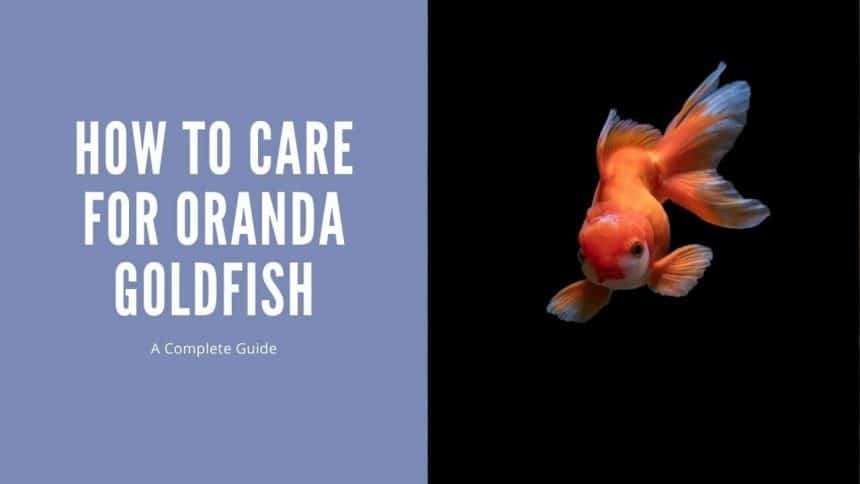
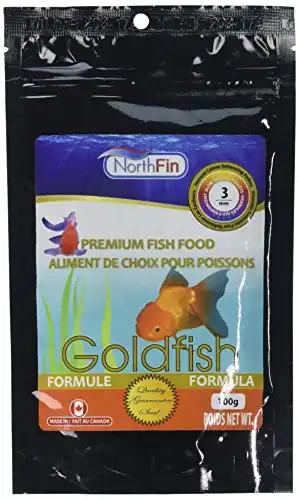






Mark, my oranda ate a Cory catfish tonight. I tried to take it out of his mouth, but to no avail. He is going to the bottom of the aquarium and just sitting there. He has not done that before. It has been over an hour and it does not look like the Cory cat has digested much. What to do besides hope for the best?!
I’m sorry to hear Sabrina. I’m wondering if there are water parameter issues that as Cory’s are warmer water fish. It may have been weak or passed away when the goldfish tried to eat it. I’ve actually haven’t seen that happen when a fish gets something stuck in its mouth like that. There isn’t much you can do unless you unless you can pull it out with tweezers. Here is a video for reference – https://youtu.be/SI8zI6Nv3gc. It’s more common for goldfish to shallow gravel, but the procedure should still be the same. Would be good to consult a vet as well if you can get a hold of one that knows fish care.